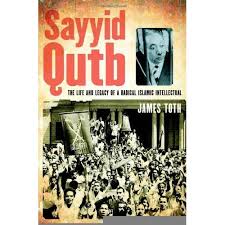|
Reviewed by Rev. Dr. D. Antoine Sutton, Semitica Language Academy James Toth has written an admirable book, filled with architectonic ideology. It is a 382 page tome of a specific kind: judicious and fair in his conduct toward Qutb’s claims, well researched, and his style of composing English is of high standard; even if it is deficient in eloquence. The book has two parts: part one, treating his life and part two examining his ideas; ending with an epilogue. There is also a third section of appendices. Part One: His Life: Toth maintains the book is offered as a response to Thomas Friedman’s “cavalier and frankly deficient manner of understanding Islamic militancy (fn.4, p.285). In the introduction he sets forth his objective as a Qutb scholar, “to find what is worthwhile in the ideas” of Qutb, and to present those concepts fairly and appropriately. A revisionary picture of Qutb comes through, one which avers that current caricatures of him are wrong indeed. He suggests that all of Qutb’s literary work needs to be comparatively studied in order to complete the man’s image; Toth inveighs against the idea of assigning too much importance to the 1964 volume ‘Signposts,’ that it does not fully represent his entire point of view. True enough, but it does illustrate his ideas and ideals. And these undergird notions fostered by radicals today: that volume, particularly, aided in fomenting of waves of violence against Egyptian citizens in his final years. In chapter two an encyclopedic survey of his early years is given; he generously remarks upon the development of Qutb’s poetic/critical style. In chapter three, oddly enough the death of his mother is noted as stimulus for his turn toward conservative Islam; extended testimony is given to Qutb’s type of Quranic exegesis. Chapter four is wide-ranging and treats of broad claims of Islam upon Qutb’s conscience, and the effect such strictures had on his transformation into a Salafi. He argues that Qutb adopted Ibn Taymiyya’s “unyielding Kharijite perspective” (p.64), seemingly on account of an American sojourn of nearly two years. Chapter five offers a relevant sketch of Qutb’s relationship with the Muslim Brotherhood. Moreover, Toth overviews the contexts in which Qutb’s commentary, In the Shades of the Quran and Signposts, were written: brief outlines of the contents of each volume are given; after which, the circumstances of his death are provided. Part Two: His Legacy: Ideas and Issues is concerned with basic mainstream principles of Islamic militancy which have been celebrated for decades by those who embrace them: i.e. ‘The Islamic Concept’ (chapter 6), which presupposes the Greatness of God, the preeminence of the Quran and the necessity of the rule of Islamic Law over societies. This precept forms the basis of chapters 7 thru 10: Islamism as a Revitalization Movement, The Islamic Society and Islamic System, The Islamic Economy and The Islamic State, respectively. Appendix: the Dramatis Personae supplies excellent, but brief biographies of notable personalities given notice in the book. Qutb’s straight-forward thoughts on family, the People of the Book and his apologetics are then expressed. However the latter essay is redundant, and already was fully handled in the earlier portions of Part Two. Regarding the Ottoman caliphate (fn.58, p.293), which was abolished at the end of World War I, did its origins truly begin 1300 years prior or did it originate nearly 500 years before with Mehmet II? All sects of Islam during the period of Ottoman influence did not recognize its legitimacy, but Toth’s statement does not guard well against the likelihood of a reader drawing the wrong inference. In another place, Toth’s declaration, “Because of the scholarship of those like Martin Bernal, it is now well recognized…” (fn.89, 295-6) is indefensible. Are we to assume that the late Martin Bernal’s arguments are conventional? Not so. “well recognized” should not be taken to mean ‘principally accepted.’ These ideas were known decades prior to Bernal’s incredible feat, which was to collect disparate materials, arrange them for display, while injecting critical comment. Toth laments the West’s one-dimensional caricature of Qutb, so he proceeds to base his entire thesis on another one-dimensional approach to the understanding of a “complex figure”: except he believes an anthropological methodology is somehow better suited for exploring his complexities. Thus he arrogates to himself an ability that evidently did not descend to other academic investigators of Qutb, as their scholarship was wrongly formed, not being based on theoretical foundations which support a ‘social movement model.’ Toth’s hypothesis is hollow, never substantiated by apposite facts. Toth confirms Qutb’s ties to the Muslim Brotherhood, but fails to record the organization’s bonds with Nazism prior to and during World War II: the index does not mention Hitler or Nazism. His citations of sociological remarks are misleading; the Freudian homo-social observations are peculiar, e.g. fn. 40, pp.308-9. His notes generally accept Quranic views and Islamic history uncritically (c.f. fn.11, p.299); amid the mass of theological summary in Part Two there is scarcely any critical engagement with the texts of the Quran which engaged Qutb; and the reading of the whole volume tends toward a lack of authoritative command of the Arabic language. Regrettably, as an anthropologist, he would not have been able to make use of professional field interviews, since those type of investigations were illegal during the course of writing. Qutb supported violent measures (pp.153-4). He was not as complex a figure as originally asserted. His progression towards a fiery brand of Islam follows a fairly straight line, not wholly uncommon to others of his type. While not his initial purpose, Toth’s research upholds a commonly known fact: that in the last century the radical elements of Islam in Egypt have not been shaped by illiterate citizens, but by cultured intellectuals whose impressions and experiences with a liberally-oriented, western world led them to oppose it and all for which it stands. Qutb’s voice booms loudly in the pages of this Oxford edition. This volume will be indispensable for a long time to come. It is a remarkable achievement, and should be hailed as such. His command of the intricacies of early Islamic history is commendable (cf. chapter 11). Students in public and private institutions of higher learning and in military war colleges undoubtedly will make their profit of it, but only if they are aided by one whose command of the histories of Islamic militancy reflects the broad and deep perspectives necessary to critically evaluate Toth’s sympathetic analyses. |


 Sayyid Qutb: The Life and Legacy of a Radical Islamic Intellectual
Sayyid Qutb: The Life and Legacy of a Radical Islamic Intellectual
